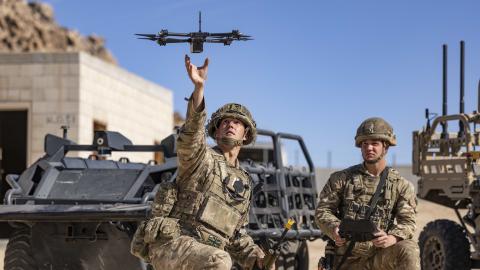The AI revolution started by ChatGPT continues to accelerate, with machine learning showing up in everything from ecommerce to tractors. And while the applications continue to explode, it’s becoming clear that AI can help smaller players compete by harnessing their data in the same way industrial behemoths have for decades.
In warfare, AI is giving a similar edge to smaller, tech-savvy militaries – for good and ill. Here are five ways AI is already finding its way onto the battlefield, and how it is likely to evolve over the next few years:
Decision-making: Generative AI tools like ChatGPT, Bard or Midjourney use internet data to train a model so it can predict how to complete tasks like writing a line of computer code or creating a new painting in Picasso’s style. These same AI techniques can also help military commanders formulate plans.
Normally, legions of planners think through each aspect of an operation, from food and fuel to missile attacks, and build courses of action for a commander to consider. Trained with data from past operations, the characteristics of the force, and estimates about the enemy, generative AI models can create plans that – although not perfect – give planners a head start. And because an AI tool can think through more options than a staff of humans, it can reveal alternatives human planners may not have considered.
Ukrainian troops are already using AI tools like these to stay a step ahead of Russian forces, while China and the U.S. are incorporating AI-enabled decision aids into their command and control systems. Fighter cockpits will soon include AI-enabled assistants that help interpret data or fly a plane while the pilot assesses the situation.
Intelligence analysis: AI-enabled image recognition has been around for about a decade. Now militaries, like some businesses, are pursuing AI-enabled algorithms to predict what intelligence data suggests about an adversary’s plans and intentions. And going one step further, AI-enabled tools will soon predict ways a nation can operate, equip and position its military to deter an opponent or make it stumble into the wrong one.
Smart weapons: Militaries already use killer robots. Automated torpedoes and missiles have been around for decades. But AI algorithms can make automated weapons smarter and more discriminating. The same way Google Translate uses AI to recognize text, algorithms help weapons not just discern a tank from a trolley, but also predict whether the tank is the best one to hit based on its location, direction of movement, and armament.
AI is also helping weapons and drones navigate. In Ukraine, satellite navigation systems like GPS are routinely jammed or spoofed. In the same way humans turn to landmarks, terrain, ocean waves, stars or radio towers to orient themselves, AI algorithms can help weapons and drones predict their location based on what their sensors see.
Predictive maintenance: Soldiers could die if weapons or vehicles break during a fight, so militaries check and replace equipment more often than needed. The result is higher costs and more time in the shop. To break that cycle, militaries – like many airlines, shipping fleets and trucking companies – are using AI-enabled tools to predict when a system or part is nearing the failure point and should be repaired or replaced. With the U.S. military becoming smaller each year, it needs every tank, ship or plane to stay online as much as possible.
Drone warfare: Uncrewed systems are where the above trends come together. The war in Ukraine and Nagorno-Karabakh show the side with the best and most drones has an advantage. Despite being outnumbered 3 to 1 on the ground and 10 to 1 in the air, Ukrainian troops stopped Russia’s advance and have slowly pushed Moscow’s forces back in no small part because of Ukrainian drone boats and aircraft.
Equipped with AI-enabled algorithms to help them navigate and avoid threats, Ukrainian drones are striking targets themselves or finding targets for artillery and rocket attacks. By getting the most out of its munitions stocks, drones are allowing Ukraine’s troops to fight above their weight. Facing missile shortages of its own, Russia also turned to drones, which attack Ukrainian infrastructure and help high-end Russian missile reach their targets.
Although a Terminator-like hellscape is not on the horizon, military applications of AI are likely to make warfare more lethal, more intense – and more competitive. Most concerning for the Pentagon, smaller and less advanced U.S. adversaries like Iran or terrorists can use AI-enabled software and uncrewed systems to level the playing field.
To stay ahead, the U.S. military should lean into AI to become more creative, precise and get the most out of every defense dollar.


















